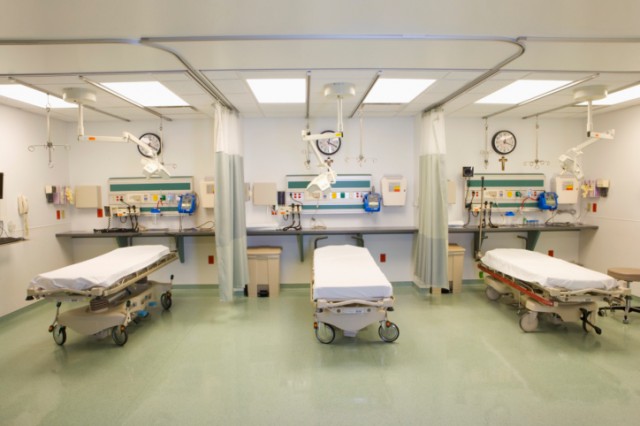Gerwig’s team is trying to figure out what’s in their stock. If they prove to be harmful, swapping out hospital beds is bound to be a big undertaking. “We have a lot of mattress,” she said. But if necessary, it's a task Gerwig would embrace.
Kaiser hospitals are among more than 100 private and public hospitals in California that are moving toward more sustainable practices for their facilities, said Laura Wenger, executive director of Practice Greenhealth.
Non-profit organizations like Practice Greenhealth and HealthCare Without Harm are hoping to turn hospitals “green.” The groups help hospitals reduce energy use, cut down on medical waste and make hospitals healthier places to visit or work in.
“We have seen many hospitals that are using quite toxic cleaning supplies even in their public areas,” said Wenger. “Why are you exposing all your staff, the general population and visitors to these increased amounts of toxins when there’s really no need for it whatsoever?”
Some of these disinfectants can be carcinogenic and exposure may lead to nausea, neurological damage and respiratory problems when emitted into the air.
This is a concern for patients but it’s an even bigger issue for hospital staff who spend their working lives in these buildings. Research has shown that health care workers who are routinely exposed to chemicals and cleaners like bleach, toilet cleaners, detergents and ammonia had greater odds of developing work-related asthma symptoms.
Practice Greenhealth encourages the hospitals it works with to use more sustainable products when safe to do so.
But it's not just cleaning supplies and potent disinfectants that are causing concern. Harmful chemicals and toxins are turning up in places you might not expect.
Wenger says “chemicals of concern" have been found in many areas throughout hospitals, "from inside of medical tubes and various medical devices," she says "to the backing in your carpeting and flooring that have certain emissions" and even formaldehyde in wall coverings.
By 2001, research suggested that DEHP, a chemical used to make plastics and vinyl more flexible, had a range of negative health effects in laboratory animals, including damage to developing reproductive organs.
DEHP has been common in hospital equipment like medical tubing, IV bags, and catheters, including equipment used on very sick infants.
“We’re trying to help [patients] by giving them lifesaving drugs -- but through a device that might have negative outcomes,” said Krisanne Hanson, the director of sustainability at Stanford University Medical Center.
Stanford and other hospitals across the state have eliminated DEPH from intensive care units for infants. Today, only a few products containing DEPH remain in Stanford’s hospitals, says Hanson.
Both Stanford and UC San Francisco have also swapped out the harmful neurotoxin mercury from a variety of medical devices, including thermometers and thermostats.
Hospitals making a move toward sustainability often ask suppliers to list which toxins are hiding in their products.
They even sweat the small stuff, items as small as identification bands.
A few years ago, Kaiser found out their regular supplier of ID bands made them with PVC. PVC emits cancer-causing chemicals when manufactured and incinerated. Today, Kaiser’s yearly allotment of about 4.4 million ID bands are made of a more sustainable tyvek material.
“There wasn’t a lot of deep thinking about it. It was just, there’s a safer alternative available and it’s affordable, so let’s go with that,” said Gerwig.
But sometimes there’s no substitute on the shelf that meets hospital standards. In those cases, Kaiser has asked companies to invent one.
Gerwig says that Kaiser sent "a very loud and clear message to suppliers" that it wanted safer alternatives "and the first people who come to us with a safer product that meets our quality and affordability standards, we’re going to go with that."
A message like that from Kaiser, which buys mountains of supplies for its 37 hospitals, can send manufactures running to the design room.
And that’s a win for other hospitals which now have access to new, sustainable products at affordable prices, said Gerwig.
